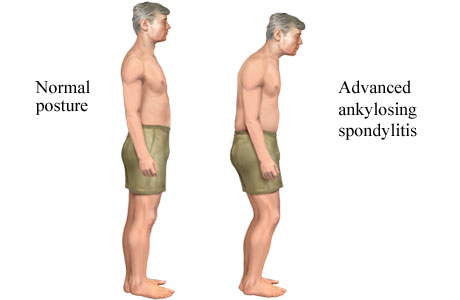Ankylosing Spondylitis Causes, Symptoms, Diagnosis and Treatment

What Is Ankylosing Spondylitis?
Ankylosing spondylitis, previously known as Bekhterev’s disease and Marie-Strümpell disease, is a chronic inflammatory disease of the axial skeleton, with variable involvement of peripheral joints and nonarticular structures.
The spine’s bones (vertebrae) may grow or fuse together, resulting in a rigid spine. These changes may be mild or severe, and may lead to a stooped-over posture.
Early diagnosis and treatment helps control pain and stiffness and may reduce or prevent significant deformity.
Ankylosing spondylitis affects men more often than women. Signs and symptoms of ankylosing spondylitis typically begin in early adulthood. Inflammation also can occur in other parts of the body — most commonly, eyes.
There is no cure for ankylosing spondylitis, but treatments can relieve pain and lessen symptoms.
Complications may include:
- Eye inflammation (uveitis).
- Compression fractures.
- Heart problems.
Causes Of Ankylosing Spondylitis:
Ankylosing spondylitis has no known underlying cause, though genetic factors seem to be involved.
In particular, people who have a gene called HLA-B27 are at significantly increased risk of developing ankylosing spondylitis.
Risk Factors Include:
- Sex
Men are more likely to develop ankylosing spondylitis than are women. - Age
Onset generally occurs in late adolescence or early adulthood. - Heredity
Symptoms Of Ankylosing Spondylitis:
The most common early symptoms of ankylosing spondylitis include:
- Pain and stiffness.
Constant pain and stiffness in the low back, buttocks, and hips that continue for more than three months.
It often starts around the sacroiliac joints, where the sacrum joins the ilium bone of the pelvis in the lower back region. - Bony fusion.
Ankylosing spondylitis can cause an overgrowth of the bones, which may lead to abnormal joining of bones, called “bony fusion.”
Fusion affecting bones of the neck, back, or hips may impair a person’s ability to perform routine activities.
Fusion of the ribs to the spine or breastbone may limit a person’s ability to expand his or her chest when taking a deep breath. - Pain in ligaments and tendons.
Spondylitis also may affect some of the ligaments and tendons that attach to bones.
Tendonitis (inflammation of the tendon) may cause pain and stiffness in the area behind or beneath the heel, such as the Achilles tendon at the back of the ankle.
Diagnosis Of Ankylosing Spondylitis:
Ankylosing spondylitis can be diagnosed via:
- A physical exam
- Imaging tests
X-ray
MRI - Lab test
Treatment Of Ankylosing Spondylitis:
There is no cure for ankylosing spondylitis.
However, treatment may provide relieve against pain and other symptoms.
Treatments include:
- Medication
Nonsteroidal anti-inflammatory drugs (NSAIDs)
o naproxen (Naprosyn)
o indomethacin (Indocin)
tumor necrosis factor (TNF) blockers
o Adalimumab (Humira)
o Etanercept (Enbrel)
o Golimumab (Simponi)
o Infliximab (Remicade) - Physical therapy
- Surgery
By : Natural Health News




